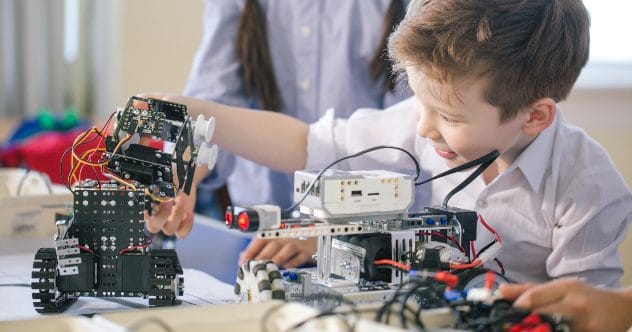Science fairs are an exciting time for students to dive into the world of discovery and innovation. But let’s be honest, coming up with a project that’s both cool and genuinely impressive can be a bit of a head-scratcher. If you’re tired of the same old baking soda volcanoes or potato batteries, you’re in the right place! We’ve gathered a list of ten science fair projects that are sure to capture attention and teach you something amazing along the way. Get ready to explore some truly remarkable ideas that go way beyond the basics!
10. Sun Tracking Solar Panel
Imagine a solar panel that cleverly follows the sun across the sky, just like a sunflower! This project focuses on building a system that ensures solar panels capture the maximum amount of sunlight. Standard solar panels stay in one position, but as the sun moves, they don’t always get direct light. A sun-tracking panel, however, automatically adjusts itself to always face the sun. This smart movement can increase the electricity generated by as much as 25% compared to a fixed panel. It’s a brilliant way to explore renewable energy and electronics.
What you might need:
- Arduino board
- Power supply
- USB cable
- Light Dependent Resistors (LDRs)
- Servo motor
- Small solar panel (for demonstration)
- Wires and mounting screws
This project isn’t just cool; it’s also incredibly useful, showing how we can make solar energy even more efficient.
9. POV Clock
POV stands for “Persistence of Vision,” and it’s a fascinating optical illusion. This project creates a clock where the numbers or images seem to float in mid-air! It works because our eyes hold onto an image for a tiny fraction of a second after the light source is gone. When a series of lights (like LEDs) blink rapidly in a specific pattern while moving, our brain pieces it together to see a continuous image. You can display text or even simple graphics with this cool effect.
Our eyes can process about ten images per second. When more than ten images are shown quickly, one after another, we perceive it as motion. A POV clock is a mesmerizing and creative project that’s sure to impress.
Components and supplies you might need:
- Arduino Nano R3 (or similar microcontroller)
- Soldering iron
- DC Motor
- Slide switch
- Resistors (e.g., 220 ohm)
- LEDs
- Linear Regulator
- 9V Battery and connector
8. Smart Irrigation System
This project is a game-changer for anyone with plants, from small gardens to larger farms. A smart irrigation system automatically waters plants only when they need it, saving water and effort. The goal is to build a system using a microcontroller, like a NodeMCU, that monitors soil moisture. When a soil moisture sensor detects that the soil is too dry, the system automatically turns on the water for the plants. It’s efficient in terms of both time and money.
With some clever coding, you could even connect this system to the internet, allowing you to monitor and control your garden’s watering from a smartphone app! This project helps demonstrate how technology can solve real-world problems like water conservation and efficient farming.
Here’s what you’ll likely need:
- Microcontroller (e.g., Arduino, ESP8266/NodeMCU)
- Soil moisture sensor
- Small water pump or solenoid valve
- Relay module (to control the pump/valve)
- Connecting wires
- Power supply for the pump and microcontroller
7. Smart Alarm Clock
Thanks to the Internet of Things (IoT), we can create amazing, cost-effective devices, like a smart alarm clock! This isn’t your average alarm. An IoT smart alarm clock can do much more, like track your sleep patterns. You could place a sensor in your bedroom to determine how many hours you sleep and whether you’re getting enough restful sleep. Some advanced versions might even try to analyze your sleeping posture to help improve sleep quality.
Plus, imagine waking up to your favorite tunes! A smart alarm clock can allow you to choose custom sounds to start your day right. Unlike a traditional clock that just goes off at a set time, a smarter version might even consider your sleep cycle to wake you at the optimal moment.
Items for a simple smart alarm clock:
- Microcontroller (e.g., ESP32, Raspberry Pi Pico W)
- LED Lights
- LCD Display
- Real-Time Clock (RTC) module
- Breadboards
- Speakers or Buzzer
- Cables and Connectors
6. Magnetic Slime
Magnetic slime is a super fun and visually impressive project, especially for younger students, though teens and adults might find it cool too! You can create a slime that reacts to magnets because it contains tiny iron particles. When you bring a strong magnet near it, the slime stretches and moves towards the magnet, creating fascinating shapes. This recipe aims for maximum fun with minimal mess.
What you need to make magnetic slime:
- Measuring spoon and cup
- Plastic spoons and bowls
- Liquid starch
- Elmer’s glue (white or clear)
- Iron oxide powder
- A strong neodymium magnet
Important Safety Notes: Neodymium magnets are very powerful. Be careful, as fingers can get pinched when handling them. Keep these magnets away from electronic gadgets. If you use small disk magnets, ensure they are kept away from young children, as they can be dangerous if swallowed. Also, avoid breathing in iron oxide powder; it’s best to mix it with the glue carefully. Despite the precautions, it’s a fantastic hands-on project about magnetism!
5. Water Alarm Project
A water alarm can be a real lifesaver for a home, helping prevent costly damage from leaks. Even small water leaks can lead to big problems and expensive repairs for homeowners. The good news is that these situations are often avoidable. A water alarm system can detect leaks early on. This project involves building a simple device that sounds an alarm when its sensor detects water.
These alarms are usually affordable and can be placed in areas prone to leaks, like under sinks, near washing machines, or close to water heaters. The sensor triggers the control unit to sound a loud alarm or even send a notification to a connected phone in more advanced setups. It’s a practical project with real-world applications.
Check out what you’ll need:
- Perforated PCB (Printed Circuit Board) or breadboard
- Soldering iron and solder wire (if using PCB)
- Battery (e.g., 3V-5V or 9V)
- Two small copper plates or wires for sensor probes
- Transistors (e.g., BC547 NPN)
- Resistors
- Buzzer or LED for alarm
4. Rain Alarm Project
The Rain Alarm Project is a simple yet very useful device that senses raindrops and triggers an alert. Water is a precious resource, and conserving it is important. This project aims to help people save water. When the alarm sounds, it signals that it’s raining, allowing someone to take action, like collecting rainwater for later use or bringing items indoors.
It’s a great way to learn about basic circuits and sensors while creating something environmentally conscious. Drawing a circuit diagram first can make building this project much easier.
Components for your rain alarm:
- Breadboard
- Battery (e.g., 9V)
- Connecting wires
- Buzzer (for the alarm sound)
- Resistors
- Ceramic capacitor
- Rain sensor (can be DIY with a small PCB and conductive traces)
- Transistor (e.g., NPN transistor like BC547)
3. Water Dispenser from Cardboard
Making a water dispenser from cardboard is a creative and impressive science fair project that shows how everyday materials can be used in clever ways. A water dispenser is handy for easily filling bottles or glasses. While you can use various materials, cardboard is surprisingly durable when constructed well, and it’s readily available.
First, decide on the size of your dispenser. You’ll need glue to hold the cardboard pieces together strongly. A straw can act as the tap, similar to how a regular dispenser has a regulator. Use a plastic water bottle (perhaps over one liter) to hold the water. This project is fantastic because it demonstrates resourcefulness and provides a cost-effective, useful item. It’s a great example of practical DIY engineering.
Items you’ll need for this project:
- Cardboard sheets (sturdy ones are best)
- A plastic water bottle
- A clear water glass (optional, for demonstration)
- Origami paper or paint (for decoration, optional)
- Hot glue gun and glue sticks (or strong craft glue)
- Drinking straw (flexible or wide ones work well)
- Sharp knife or box cutter (adult supervision needed)
- Metal ruler
2. Air Cooler Working Project
Beat the heat with this simple yet effective DIY air cooler project! It’s a fun way to learn about basic cooling principles. You’ll need to find or buy a large plastic jug or container. A box cutter will be handy here (with adult help, of course!). Cut an opening in the lid of the jug, matching the size of your DC motor. Then, mark and make holes in the upper part of the jug for air to flow.
You might use a smaller container or opening on one side of the larger jug to direct airflow. After assembling the jug parts, connect the wires, battery, switch, and DC motor. The motor, with a fan attached, will go through the hole in the lid. Add ice cubes to the jug, turn it on, and test your homemade air cooler! It’s a practical demonstration of evaporative cooling and basic electronics.
Essential tools for this science fair project:
- Small Fan blade
- DC motor (to spin the fan)
- Battery (e.g., 9V) and battery connector
- Wires
- Switch
- Hot glue gun
- Scissors
- Box cutter (adult supervision recommended)
- Large plastic jug or container
- Ice
1. Earthquake Alarm
Natural disasters like earthquakes can happen unexpectedly. An earthquake detector or alarm is a system designed to sense the vibrations from an earthquake and alert people. Early warnings can be crucial for safety, giving people time to move to safer locations or seek help. This project demonstrates a simple way to build such an alarm.
The concept often involves a pendulum or a loosely connected circuit that closes when shaken, triggering an alarm. It’s a very impactful project that highlights how science can help protect lives and property. This project is not only educational but also shows the importance of preparedness.
Materials you need for your earthquake alarm:
- Cardboard of different sizes (for the structure)
- Buzzer (for the alarm)
- Metal nuts or washers (for the pendulum/sensor part)
- Copper wire (bare and insulated)
- 9-volt battery and connector
- Metal ruler
- Color paper (for decoration, optional)
- Hot glue or strong adhesive
- Small screws or paper fasteners
These science fair projects offer a fantastic blend of learning, creativity, and real-world application. From harnessing solar power more effectively to creating devices that can help in emergencies, each idea provides a unique opportunity to explore scientific principles in a hands-on way. Remember, the best projects come from genuine curiosity and a willingness to experiment!
Which of these science fair projects caught your eye? Do you have other cool ideas to share? Leave your comment below and let us know your thoughts!










